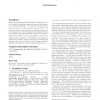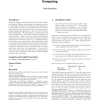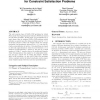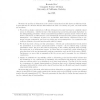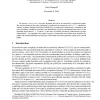STOC
2004
ACM
15 years 5 months ago
2004
ACM
Given d (0, ) let kd be the smallest integer k such that d < 2k log k. We prove that the chromatic number of a random graph G(n, d/n) is either kd or kd + 1 almost surely.
STOC
2004
ACM
15 years 5 months ago
2004
ACM
The problem of finding a local minimum of a black-box function is central for understanding local search as well as quantum adiabatic algorithms. For functions on the Boolean hype...
STOC
2004
ACM
15 years 5 months ago
2004
ACM
STOC
2005
ACM
15 years 5 months ago
2005
ACM
STOC
2005
ACM
15 years 5 months ago
2005
ACM
Abstract. We present a deterministic O(log n log log n) space algorithm for undirected stconnectivity. It is based on a space-efficient simulation of the deterministic EREW algorit...
STOC
2005
ACM
15 years 5 months ago
2005
ACM
We continue the study of amplification of average-case complexity within NP, and we focus on the uniform case. We prove that if every problem in NP admits an efficient uniform alg...
STOC
2005
ACM
15 years 5 months ago
2005
ACM
We present a quantum algorithm for the computation of the irrational period lattice of a function on Zn which is periodic in a relaxed sense. This algorithm is applied to compute t...
STOC
2005
ACM
15 years 5 months ago
2005
ACM
We study the problem of obfuscation in the context of point functions (also known as delta functions). A point function is a Boolean function that assumes the value 1 at exactly o...
STOC
2005
ACM
15 years 5 months ago
2005
ACM
We study the spectral norm of matrices M that can be factored as M = BA, where A is a random matrix with independent mean zero entries and B is a fixed matrix. Under the (4 + )-th ...
STOC
2005
ACM
15 years 5 months ago
2005
ACM
We present a deterministic, log-space algorithm that solves st-connectivity in undirected graphs. The previous bound on the space complexity of undirected st-connectivity was log4...

